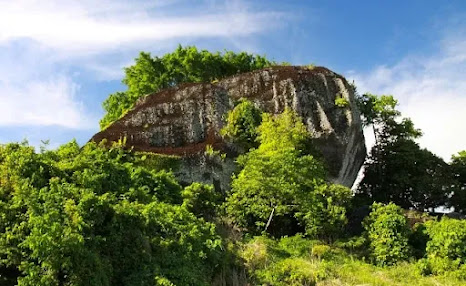Bukit Tengkorak studies the early human activities in the past.
About Bukit Tengkorak
Many people do not know that Semporna, in Sabah, is the most important archaeological site in Southeast Asia and possibly the world.
The history of Bukit Tengkorak
The locals had long known about the existence of Bukit Tengkorak before the discovery. However, this place was only identified by JMS in the 1980s, and only then did scientific researchers discover it. Then, in 1994, JMS in collaboration with USM began a more comprehensive archaeological study at the location. The locals initially called this archaeological site Bukit Kabongan. but geologists call it ‘Hood Hill’. But after th discovery of two human skulls and skeletons on the hill, the title was changed to Skull Hill. Datu Panglima Abdullah National Secondary School (SMK) in Semporna has a science laboratory for human skeletons found. Excavation studies at Bukit Tengkorak also found human skulls and tens of thousands of ancient pottery fragments with various patterns.
What are the artifacts archeologists had found?
The analysis of the archaeological site shows that various types of prehistoric artifacts around 3,00 years old have been found there. Important artifacts identified include stone tools and animal remains consisting of fish bones and sea shells. On the other hand, the most abundant artifact found in the area is earthenware. At Bukit Tengkorak, you can find various types of pottery, including pots, tajau, and cooking stoves, which in the Bajau language are called 'lapohan'. Every surface of the artifact is filled with a variety of different carving art. There are also rocks such as obsidian, slate, agate, and rijang that are used to make stone tools such as hammers, pickaxes, splinters, and drills. But faunal habitats include shells, bones of mammals, reptiles, and various types of marine fish.
The artifacts found in Bukit Tengkorak.
Why Bukit Tengkorak is important to archeologists?
Bukit Tengkorak (Skull Hill) near Semporna has been identified as the largest Neolithic ceramic manufacturing site in Southeast Asia. -Travelfish
The archaeologist studied the past is because they wanted to understand human history. For example, in this place, the archaeologist wanted to know what activity is that humans had in the past in that place. As we can see in Bukit Tengkorak, the archaeologist discovers two human skulls and a skeleton, which means there is activity at the sites. The discovery of various types of pottery, including pots, tajau, and cooking stoves said that there is the activity of making pottery and cooking in human history happened in that places.
To sum up, Bukit Tengkorak in Semporna, Sabah, is a significant archaeological site with enormous historical and cultural significance. The findings at Bukit Tengkorak have provided insight into the local activities of earlier human groups. Our knowledge of human history and the rise of Southeast Asian civilizations have been aided by the archaeological work done at Bukit Tengkorak and the examination of the artifacts. Archaeologists seek to understand historical cultures' behaviors, practices, technology, and cultural norms in order to further our understanding of the evolution of humanity.



.jpg)

Interested!, I only know a bit knowledge about this Bukit Tengorak, Thanks for this information,it really help me to know more about this history.
ReplyDelete